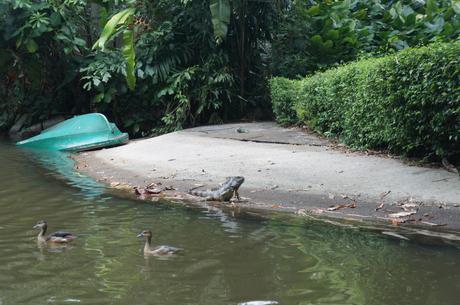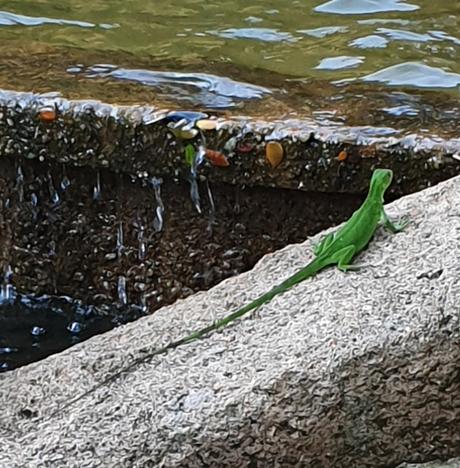
The goal of developing an alien-species warning system is to remove the species locally and to allow others enough time to take actions that prevent further spread.
For the green iguana (Iguana iguana) however, its > 50-year spread around the globe continues as we show in our latest study by using citizen-science data. We demonstrate how pet owners and recreational parks have facilitated the green iguana’s spread to mainland Asia, and project its potential future Asian range in the absence of immediate actions.
Do you know how best to deal with an invasive species? Avoid them in the first place.
There is broad agreement among scientists and conservation practitioners that the first line of defense against invasive species is prevention. Once established, invasive species can cause agricultural damage, compete with native species for space, become predators, or carry with them and introduce new diseases. We’ve seen this time and again, with some infamous examples including zebra mussels in the Great Lakes of North America (1), cane toads in Australia (2), and Asian tiger mosquitoes around the world (3).
To stop the list of invasive species from growing, it is important to detect spreading and newly arriving species early, ideally before they become established. Early detection is especially evident for green iguanas, given their high rates of population growth (females can lay up to 70 eggs), although detectability can be particularly challenging in forested spaces.

Heavily traded beyond its native range (4), the green iguana was already a wide-spread alien species when two studies assessed its impact and potential range within the Caribbean and Pacific regions (5,6). Within the Caribbean, its spread caused particular worry over interactions with its Critically Endangered sister species Iguana delicatissima (7), as well as its potential to damage agricultural production given rapidly growing populations (8).
The success of the green iguana’s ability to establish in novel regions should have served as a cautionary tale for other countries with suitable climates (tropics), but the warnings seem to have gone unheard. In our study, we used public data sources (FaceBook, iNaturalist and photo repositories) to map the spread of free-roaming iguanas in mainland Asia.
We found that since 2016, the green iguana has been spotted in at least 12 locations across Thailand and 17 locations in Singapore, with a total of 147 sightings (9). In both countries, these animals are directly released by private owners and are even allowed to roam freely within nature parks and zoos.
It is important to understand that these images were taken by the general community, without the intent of mapping all locations, which we believe will sharply increase if experts were to attempt more comprehensive surveys. We argue that green iguanas are already established in mainland Asia, and have so far been underwhelmingly ignored by the scientific community and relevant authorities.

To try and slow their spread, we identified areas that are most vulnerable to establishment by green iguanas, and provided best practices for the handling of the species when exhibited. Using habitat preferences and occurrence records, we modelled which regions of mainland Asia have suitable habitat for the green iguana.
Alarmingly, over half of mainland South East Asia has climatic conditions that favour establishment of this species, if it arrives. Thus, control is necessary to both stop continuing release and the subsequent spread. Instead of allowing iguanas to roam freely in zoos, we suggest putting up barriers like those for cheetah. Build a trench. Line the walls of the exhibition area with unclimbable smooth material, like metal sheets. Avoid overhanging trees or materials that green iguanas could climb to escape.
Evidence suggests that the green iguana is already making its way through Asia, given that we found images of free-roaming lizards in Peninsular Malaysia and Hong Kong. If this continues unattended, the species could reach population sizes in the order of millions. Will the stories of the Caribbean repeat themselves in Asia? Our paper illustrates how the green iguana might continue its Asian spread, of which the consequences are yet to be seen.
Time and again, we find that eradication is the least-feasible option for dealing with invasions, leading to staggering removal costs. Unattended, the green iguana could reach unmanageable populations sizes as demonstrated from several countries.
On the Caribbean island of Grand Cayman (Cayman Islands) an intense population-control program has been ongoing since 2019 (10). At a cost of ~ US$5 million, managers have removed just short of 900,000 iguanas. The program mainly seeks to reduce the population without entertaining that the idea of eradication is even possible. Similarly in Fiji, a multi-million $US project was started to gain data on the green iguanas there and initiate action.
Beyond iguanas, successful eradication programs measured against the number of invasive species and their spread are generally few and far between. Alhough examples of successful eradication do exist (e.g., goats from the Galápagos) (11), removal of alien mammals can result in vegetation renewal, as the case of goats and rats removed from the Caribbean island of Redonda demonstrate. Eradications of rats are known from the Caribbean (12), but especially from New Zealand where many islands have been freed from this pest (13).
The first step towards preventing a further increase in global invasive populations is acknowledging the problem; indeed, even many governments currently do this.
However, why are these populations then still increasing? Upon first arrival, it generally takes time for a new species to be recognised by experts. Here, citizen science is a great advantage as free accessible images become instantaneously available. With alien species arriving naturally (14), or through human assistance (15), relevant (governmental) organisations always need be on the lookout — citizen-science data only aid their efforts.
Christina N. De Jesus Villanueva & Matthijs P. van den Burg
References
- Berkman, PA et al. (1998). Zebra mussels invade Lake Erie muds. Nature 393: 27-28
- Urban, MC et al. (2008). A toad more traveled: the heterogeneous invasion dynamics of cane toads in Australia. Am. Nat. 171: 134-148
- Benedict, MQ et al. (2007). Spread of the tiger: global risk of invasion by the mosquito Aedes albopictus. Vector Borne Zoonotic Dis. 7: 76-85
- Stephen, C et al. (2011). Survey of status, trade, and exploitation of Central American iguanas. Iguanas Specialist Group – International Iguana Foundation. TRAFFIC- USFWS-UVU
- Falcon, W et al. (2012). March of the Green Iguana: Non-native distribution and predicted geographic range of Iguana iguana in the Greater Caribbean region. IRCF Reptiles & Amphibians 19: 150-160
- Falcon, W et al. (2013). Biology and impacts of Pacific island invasive species. 10. Iguana iguana, the green iguana (Squamata: Iguanidae). Pac. Sci. 67: 157-186
- van den Burg, M et al. (2018). Iguana delicatissima. The IUCN Red List of Threatened Species 2018: e.T10800A122936983
- El Nuevo Día (2009) Ingenio Ciudadano Contra la Iguana iguana
- van den Burg, MP et al. (2020). The continuing march of common green iguanas: arrival on mainland Asia. J. Nat. Conserv. 57: 125888
- Rivera-Milan, FF, & Haakonsson, J. (2020). Monitoring, modeling and harvest management of non-native invasive green iguanas on Grand Cayman, Cayman Islands. Biol. Invasions 22: 1879-1888
- Cruz, F et al. (2009). Bio-economics of large-scale eradication of feral goats from Santiago island, Galápagos. J. Wildl. Manage. 73: 191-200
- Witmer, GW et al. (2007). The successful eradication of introduced roof rats (Rattus rattus) from Buck Island using diphacinone, followed by an irruption of house mice (Mus musculus). Wildl. Res. 34: 108-115
- Towns, DR, & Broome KG. (2003). From small Maria to massive Campbell: Forty years of rat eradications from New Zealand islands. N. Z. J. Zool. 30: 377-398
- Censky, EJ et al. (1998) Over-water disperdal of lizards due to hurricanes. Nature 395: 556
- van den Burg, MP et al. (2020). Post-hurricane relief facilitates invasion and establishment of two invasive alien vertebrate species in the Commonwealth of Dominica, West Indies. Biol. Invasions 22: 195-203

